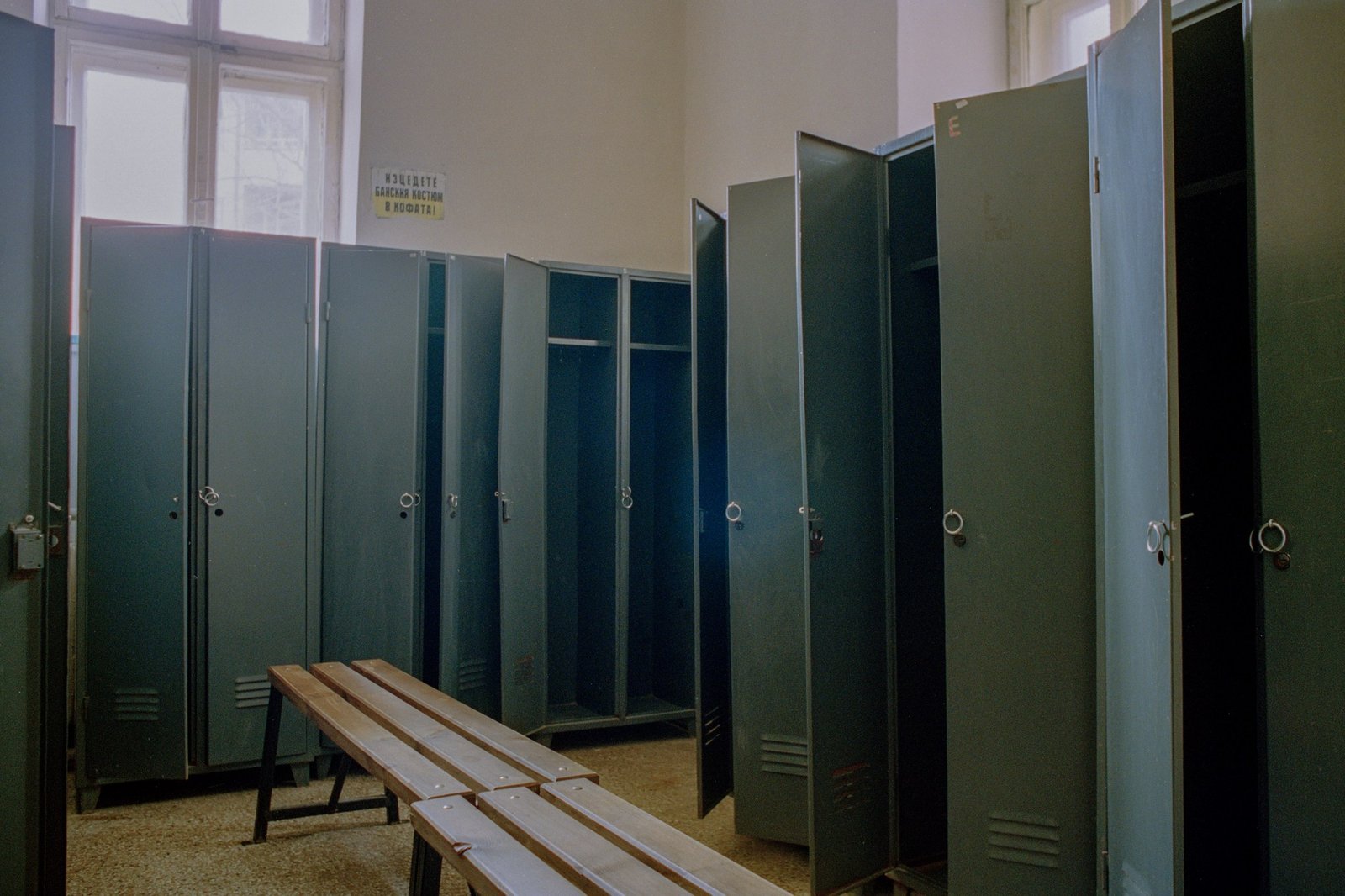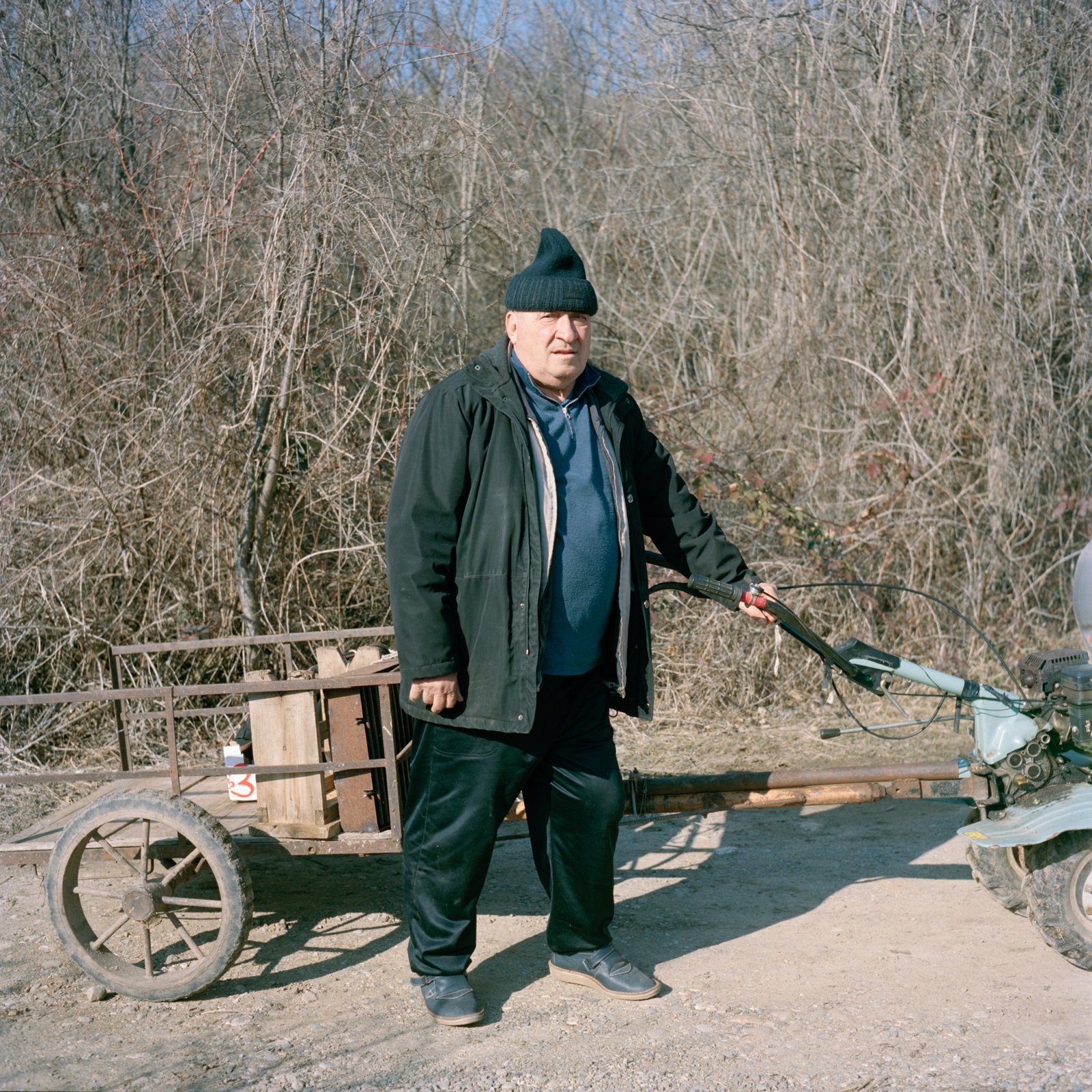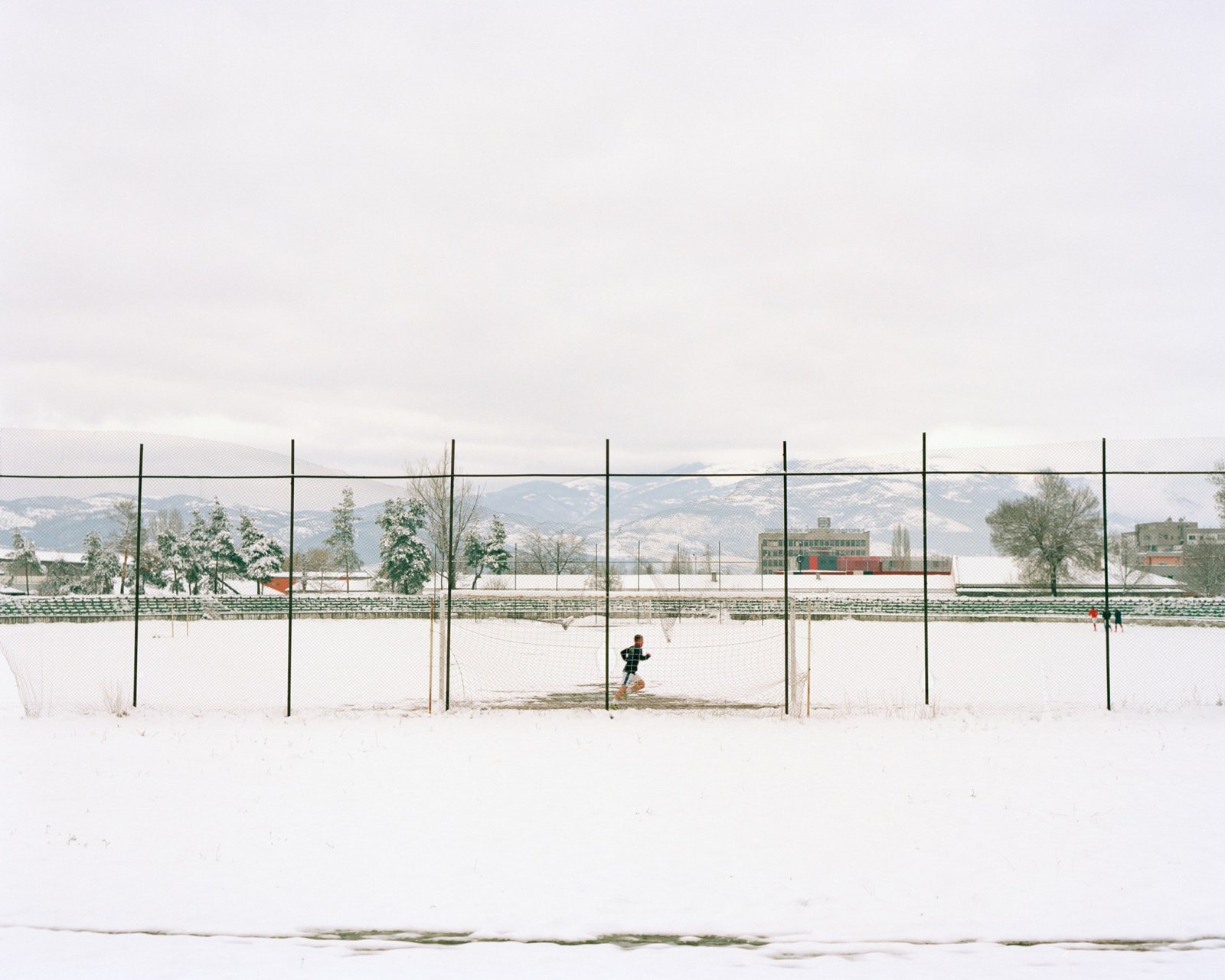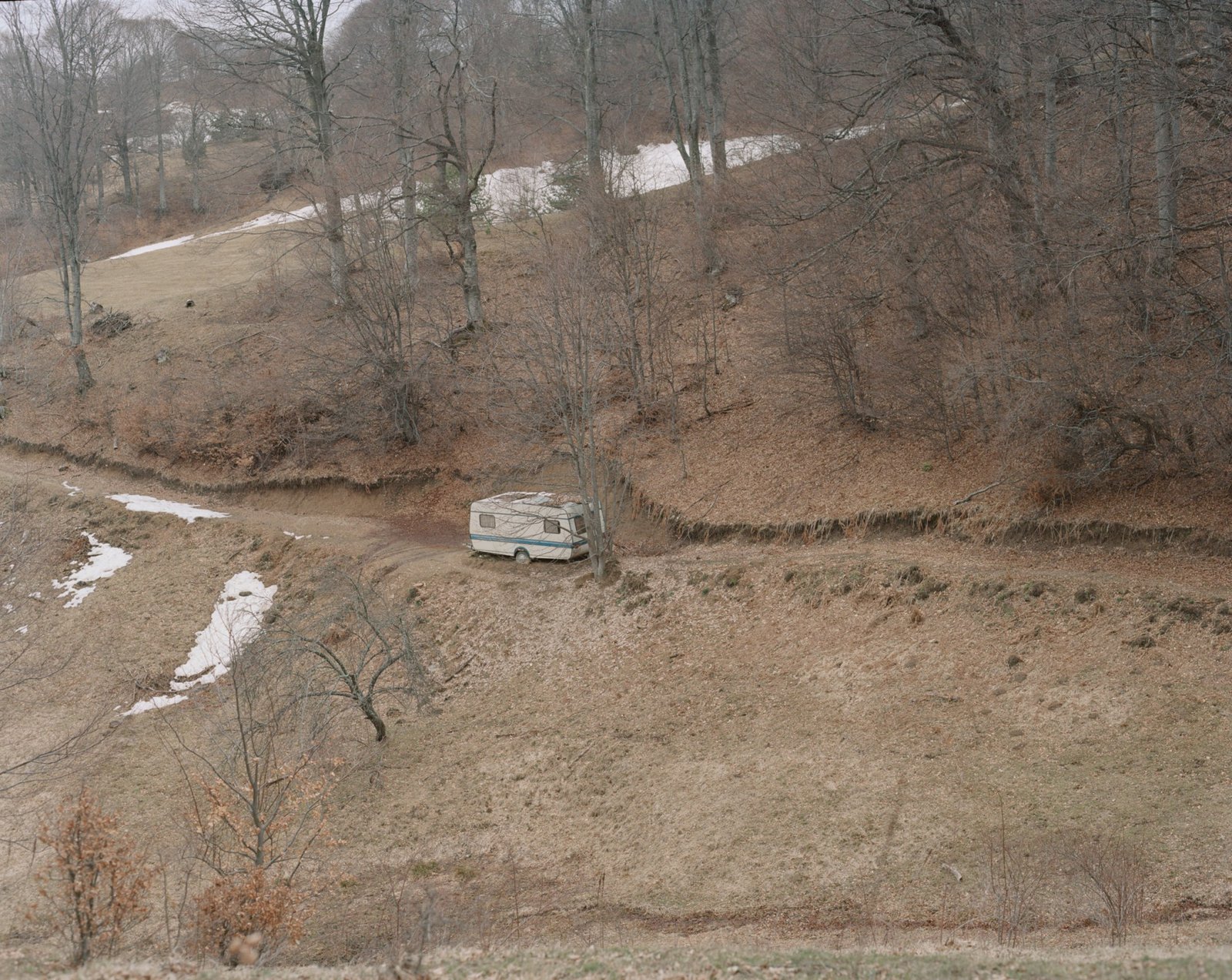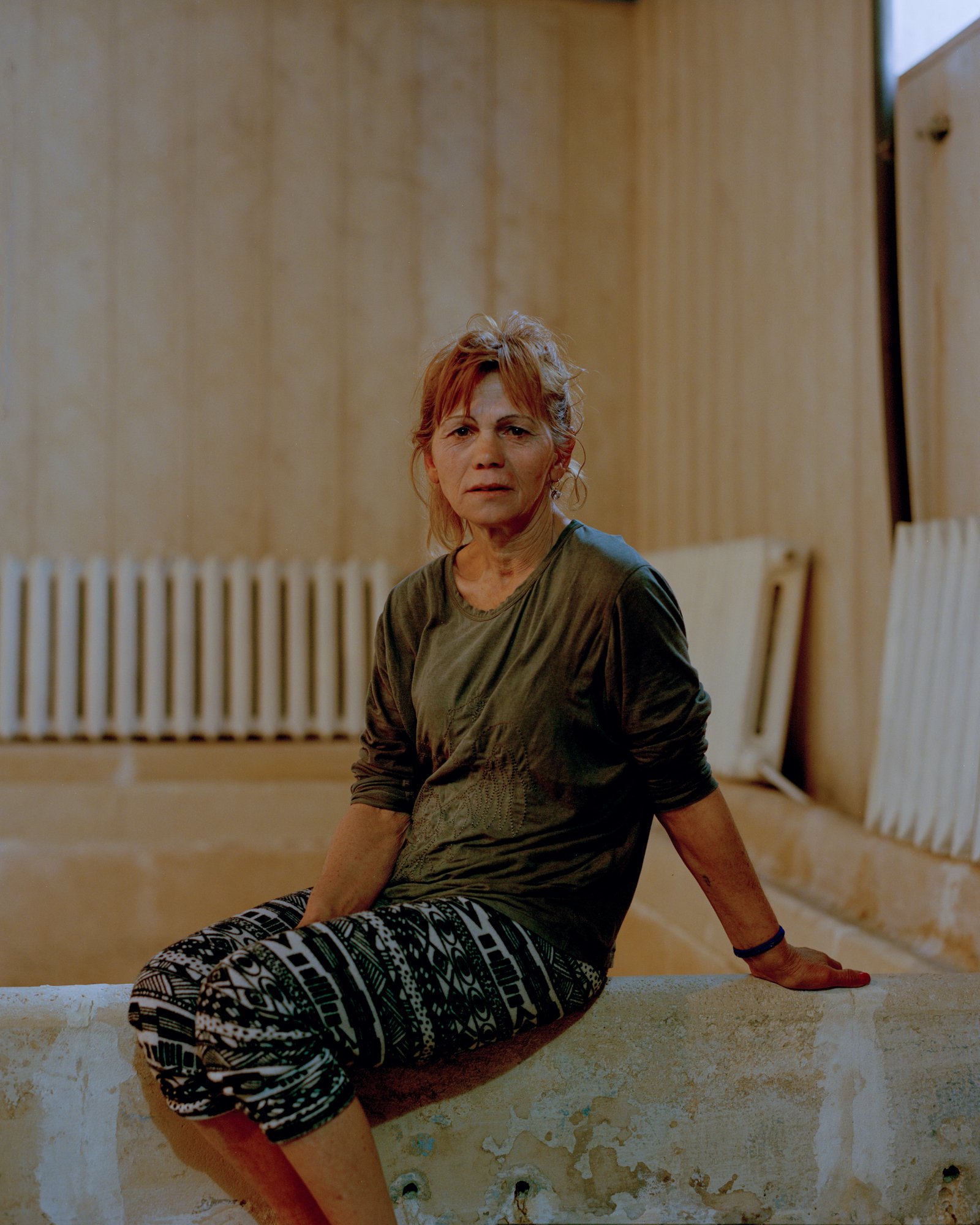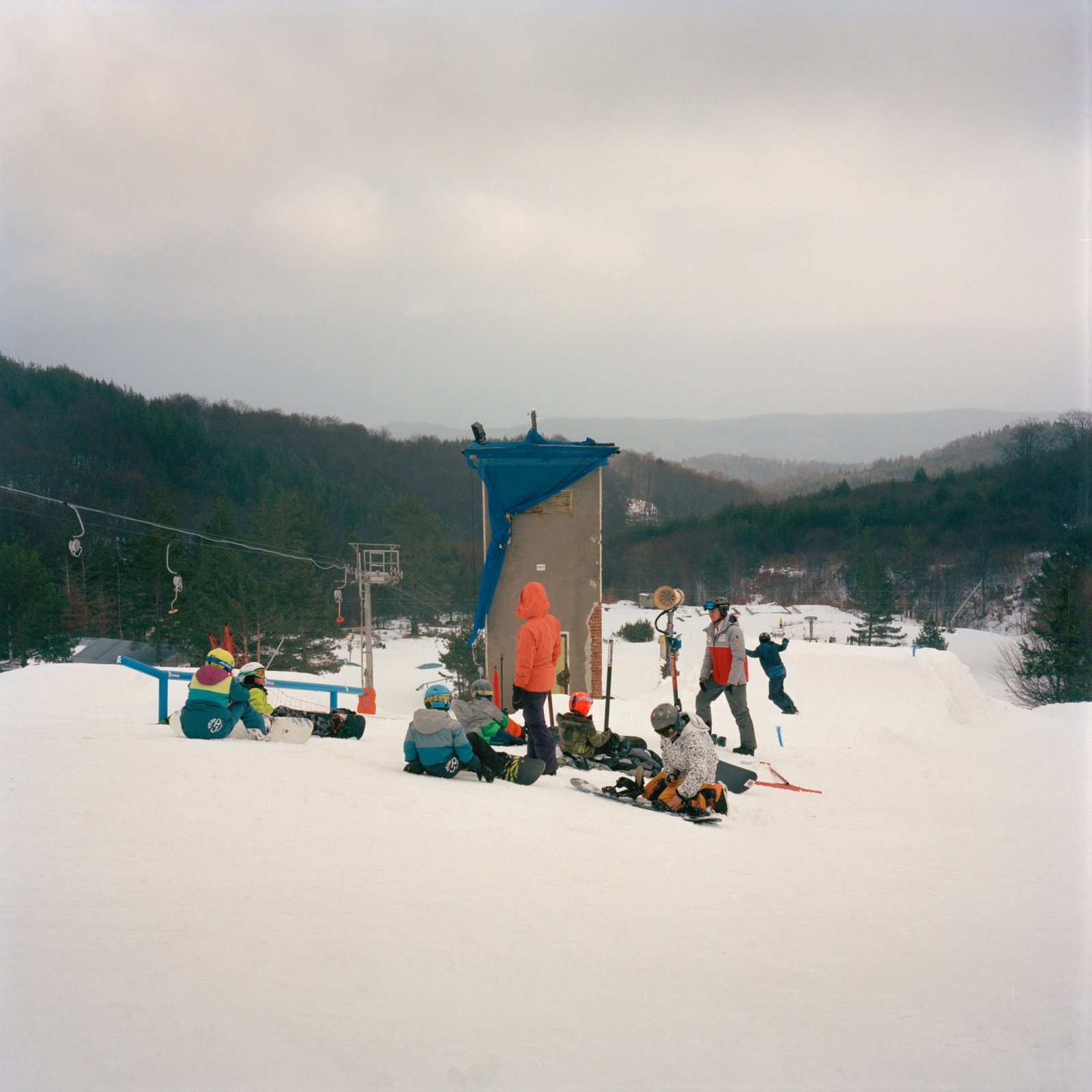‘Giants above The Cherries’ is a metaphorical farewell to the town of Kyustendil, Bulgaria – Petar Petrov’s hometown and where he spent the first 19 years of his life. The series touches upon Petrov’s connection with the places and people, the scenery, and the pervading sense of abandonment. Woven into the work are narratives that explore specific issues associated with the place itself; the infrastructure, the youth, resources, culture, ethnic discrimination, and the transition from a socialist to a capitalist governing. We got to chat to Petar about his project and the book that he made to go alongside it.
You mention your work is solely not documentary based, although this series screams that you’ve been working on documentary photography for a long time. What inspired you photographically for the series?
I would like to begin with that I haven’t been working on documentary photography particularly much to which it really flatters me that it comes across as such. I have always loved experimenting with a documentary approach but I never took it seriously until I started to create ‘Giants above The Cherries’, which was roughly two years ago.
I found myself inspired by photographers like Stephen Shore, Alec Soth, Chloe Dewe Mathews, Rineke Dijkstra, and several other Western documentary photographers. However, I realised I had some sort of resentment towards their work. I found I couldn’t really relate to their work on a personal level. I wanted to create a personal project and I needed to be inspired by something close to home. The closest project I researched that came to that is ‘Beyond the Forest’ by Clare Richardson because of her choice of the subject being somewhat close to my home geographically.
With the risk of coming across as unconventional, I wanted to create images that I could trace back to my roots as an Eastern European. One particular artist that inspires me in such a way is the film director Andrei Tarkovsky (1932 – 1986). In fact, cinema is an art form that has always inspired me to create work, although this is a topic for another time. However, several years ago when I discovered the book ‘Instant Light’ by Tarkovsky is when I felt I finally clicked with a piece of work that really spoke to me. The soft instant images depicting landscapes and still lives from Russia and Italy as well as the occasional portraits of Tarkovsky’s family members in rural settings resonated with me. It felt like those photographs were a part of me that I never discovered. I knew those images were intended to be something personal and I believe this is what gave me the spark to do something similar. Something honest.
On a further note the poetry that was accompanying the photographs, I found incredibly astonishing. The whole idea of the book spoke nostalgia for me, something I’ve been feeling quite a lot since I came to the UK. From there I knew the direction I needed to take in order to create my work. It is also how I considered incorporating literature with my photographs as well. I will talk more about this in one of the next questions. Another reference I would like to mention is Bulgarian Photographer Pepa Hristova (b. 1977). Her work, in particular, ‘Sworn Virgins’, gave me insight as to how I can work with the Balkan landscape and the stories that unfold there. Through her work, I found a charm about my home that I didn’t really think much about. I took it for granted, which I fear might have been my biggest mistake when it comes to my photography. I did not pay as much attention to my surroundings as much as I do now.
Can you explain the name, ‘Giants above the Cherries’?
The name was something that came up as a thought when I was photographing an orchard of young cherry trees on the way to the village where my mother grew up, called Stensko. I must admit it was a very spontaneous thought but one that kept me thinking for long.
I found myself in this field and I was so focused on the field and the trees that I hadn’t really thought about looking in the distance. However this time I did. I looked everywhere around me and I realised that I was all surrounded by mountains. The geography of the Kyustendil valley is something that is not new to me but it wasn’t till that moment that I actually stopped to marvel at it. It was like seeing a landscape for the first time.
Just as incredible are the cherries. I grew up surrounded by them. There are even cherry trees on the streets of Kyustendil and there are vast fields of cherries all around the town and nearby villages. Sometimes it is even sickening how many cherry trees there are in the area. It becomes too sweet. But to me, it only speaks volumes about how ingrained in the identity of the town and its people they are.
I realised I came to be who I am because of those mountains and cherries. At that moment the name clicked. It was a simple thought but it had so much to say. About the landscape, about the people there and especially about my memories from there. But the name was also a healthy amount ambiguous. In my ears, it has a ring to it. It said enough. It prepares the viewer for a story and on a fundamental level, I see photography primarily as storytelling.
You describe the series as ‘a farewell to your hometown of Kyustendil, Bulgaria’. Tell me the process of how you said goodbye to your hometown within a series of photographs?
When I came first to the UK I was ready for something new. I was ready to explore a completely new place, new culture, new people and ideas. Simply put a new way to live. However, I always felt I had unfinished business back home, both in terms of being a photographer and an individual. I still feel nostalgia towards it and I don’t think this feeling will ever disappear. If anything it might amplify as time goes on but I felt I had subjects there that I had to photograph at my current stage of life. On a personal level, the act of photographing for me is something that relieves anxiety. I had stored a lot of that and I knew it was time for me to release it in a form I felt comfortable with. This is why I was revisiting places in my hometown that reminded me of my childhood and adolescence. This is also why the predominant link between the projects I have done so far is the idea of memory, what it is and how it can make us feel. Additionally how we react to that memory too. Is it a fond memory or something that might haunt us? However, I knew it was time to say farewell to those anxieties. I had to photograph them to do so. I also had to be as honest as I could. Also, I had to be very accepting even if the project didn’t really fulfil its purpose. I must admit that I had doubted the success of what I wanted to create many times during the production of ‘Giants above The Cherries’ because sometimes I didn’t feel ready to reconnect with those feelings that I was trying to relieve. I was still scared to an extent. Though it eventually became easier. I achieved what I wanted with this project, however, I think there is a lot more inspiration that can be drawn from that idea. I’m almost certain that in some unknown period of time I would like to go back home to photograph even more specific subjects in the town.
You created a very interesting book for this project, in which throughout you included little pieces of paper with writing on. Could you explain the reasoning behind this?
What is written on the pieces of paper are actually poems from a classical Bulgarian poet who goes by the name of Peyo Yavorov (1878 – 1914). The four poems’ titles are ‘Motherland’, ‘Nirvana’, ‘Brethren’ and ‘Mother’s Love’. They are there to prepare the viewer for the narrative that is to follow in the chapter after reading the poem.
However, I did make the choice not to translate them into English because of two main reasons. The first one is that I don’t feel like I possess the linguistic skills to translate his words and still retain the power they possess. The second and more important is that I have a love-hate relationship with Bulgarian poetry. I grew up annoyed by the work of a lot of Bulgarian poets because I didn’t understand what they were talking about. A lot of them were very patriotic, Ivan Vazov (1850 – 1921) being a prime example. Growing up it was obligatory to be able to recite poetry that was about our national identity. Although patriotic is not what I would consider myself to be. Yavorov, however, was talking about personal things. He was honest to the core.
But it wasn’t until I spent some time in the UK that I realised how incredible Yavorov’s poems actually were. Much like how I connected to Tarkovsky’s polaroids, I experienced a similar connection to these poems and several others that didn’t exactly fit in my book. I knew I had to put them in the project as a way to contextualise not only the smaller narratives involved in the larger story but also the project as a whole. ‘Giants above The Cherries’ is not only about documentary but more so about internal feelings. However, I do recognise that these poems are a bold decision on my behalf. I intended this project to be something that I would present mostly here in the UK as opposed to Bulgaria. Putting Bulgarian poetry seems contradictory of that intention. I understand that to the viewers who cannot read them it might come across as confusing or even inconsiderate of me to include them. Leaving the viewer without the whole experience can create a sense of being left out which I greatly understand.
Although with this decision, it’s not my intention to make it confusing or ambiguous. If anything, I want to create a sense of cultural background by the use of language in my book. It would be too comfortable to go to the cinema to watch a film, which is set in Eastern Europe and every single word is in English. If the viewer wants to immerse themselves in my photographs they must accept the presence of my native language as well. I do not expect anyone to learn Bulgarian or to try and translate it themselves in order to understand why those poems are there. What I am expecting is for the viewer to acknowledge that if I was to translate them, so much would have been lost in translation.
I’ve read that your book is split into 4 parts. Could you explain what these are and the idea behind it?
As aforementioned in the previous question, each chapter explores a smaller story. The first chapter starting with the poem ‘Motherland’ is the begging of a journey. One from the airport in Sofia to the streets of my hometown in Kyustendil. This chapter is all about taking you in and around the town and the landscape surrounding it. Exploring the nooks and crannies, having a look at the people there and familiarising yourself with the environment. It is a way to ease the viewer into the setting where the story I want to tell takes place. A note I like to make is that the majority of portraits I did for this chapter are of boys in their teens. With that idea, I wanted to draw the focus on a particular demographic in Kyustendil. One that I was once a part of.
The second chapter starting with ‘Nirvana’ is one where I draw a focus towards another aspect of the identity of Kyustendil, which is the natural hot springs we have there. I haven’t mentioned the springs yet so let me give a bit of context. Historically the first settlement where my hometown is now was Thracian. Further on it was conquered by the Romans who capitalised on the fact that the Thracians had discovered natural hot springs in the area. Thus turning it into a town where that water was greatly appreciated and utilised. They built baths some say that they were favoured by rulers and aristocracy.
They even attributed legends to the water. Some say that the fertile soils of the area are because of the nutrients the hot springs spread. Another legend states that if we were to anger the spirits of the area, hot water will erupt from the closest mountain nearby, called the Osogovo. It will scorch all matter of life and turn the valley into a boiling basin. For the knowledge that I have such possibility is out of the question but I grew up as a child with those stories. It was a topic I wanted to focus on however I wanted to make a current statement about how the town utilised that resource. This is when I photographed one of several local bathhouses, called Relaxing House. It hadn’t been renovated in many years however it was in the process to be. Though due to its status as cultural heritage because of the Roman pool housed inside, the renovation was taking so long that the place was in some regards falling apart more than it was being rebuilt. I wanted to document its state and the states of other water-related facilities like the pools in which I used to swim as a child. Additionally, I wanted to document it because of my own memories of those places.
The third chapter ‘Brethren’ is one dedicated to one very particular feeling. The urge to escape. The small town can be confining. While its beauty is admirable, it can also get boring very quickly. An especially present feeling shared between many teens and adolescents living in my town. Among them are myself and my friends that I grew up with. We always talked about how one day we are going to escape from there, venture into different lands. We all share lots of hopes and dreams. Eventually, they started to come true. Shortly after we graduated from high school, I found myself in the UK along with some of my closest friends, but not all of them. The others from them went to different countries too, either to study or to work. We achieved our escape but at the same time, we became scattered. Gone were the days where all of us were a short walk away. Or when gathering in the evening didn’t require plans for months ahead. Might I add there are quite a few of us guys. So sometimes it can be difficult for us to organise a time where everyone would be free. However, this is how I grew up and my arrival in the UK had greatly disrupted that comfort. I wanted to capture that feeling by exploring places we have shared memories. Also, I did have a few portraits of some of my friends in the book too. However, they don’t like to be photographed much so I had very few images to work with.
The last chapter ‘Mother’s love’ is the most personal one. With it, I was specifically looking to explore my roots, primarily on my mother’s side of the family. Up until I reached fourteen years, me, my sister and my mother would regularly visit my grandparents who lived in the village Stensko which I already mentioned. It takes about 25 minutes to drive there from Kyustendil. The landscapes on the way to there are incredible. I always stared out of the car window when traveling to the village. Since I was a child these landscapes fascinated me. Orchards riddled with cherry trees. Mountains protecting them on all sides. It is in such an orchard where I came up with the name. The landscapes I took for the final chapter are images I’ve seen so many times as a child. It made sense for me to materialise them into photographs even if I wasn’t understanding exactly why at some points.
These journeys to the village ceased once my grandparents passed away. Or at least they were much less often than before. That was another reason why I wanted to photograph those landscapes. Naturally or unnaturally the landscape changes. I wanted it to remain static. It wanted to remember it as close to how I remembered it as a child. I applied a similar approach to the portraits of my family. However, I prefer to leave the portraits more open to viewer interpretation as there are other ideas I touch upon them.
The ending of the book is a short story that summarises the entire project in a more poetical manner. It is also my first experimentation with literary expression which I haven’t done much of, especially in English up until that point. However, I would like to keep it as a piece of the book. I do not believe it holds the same power unless the viewer has experienced all the images in the way I’ve intended them to be experienced.
Do you have any more documentary projects that you want to work on?
First I’d like to mention that I don’t consider myself to do documentary if we’re defining it as reportage. I like some aspects of the conventions it proposes and I like to incorporate them into my work however I’m too biased to deem my work as solely documentary. If I don’t feel what I’m photographing to some degree I’m never happy with my results. Back to future projects: I have many ideas. In fact too many for my own good. One I’m currently in the early stages of development is that I’m photographing places there people have separated with a loved one. Another idea I have is that I want to examine more closely the recent history of my country. More specifically the Soviet period of our history which started shortly after World War 2 and ended on the 10th of November 1989. I very lightly touch upon that in ‘Giants above The Cherries’ however I didn’t want that to be a particularly large focus of the project, but more something in the background. I want to discover more about how this period of history impacted my generation in whatever manner.
But I also still want to experiment more. After I finished ‘Giants above The Cherries’ I discovered ways of photographing I wasn’t akin to. I was very strict before, preferred controlled environments, planning thoroughly and working to achieve technical perfection to the best of my capabilities. This project, however, turned me to a different style of shooting. A raw approach to photography. One which makes me focus more on photographing because I’m feeling something about what is happening outside of the camera. I still value technical execution but to a point where it is enough to convey a feeling and emotion. Also coupling it with expressive literature, written by me or by someone else, I believe makes the image clearer. Not just an image but more like a story.
